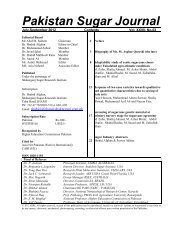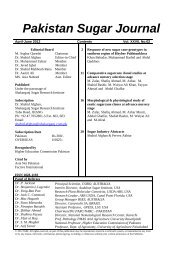Pakistan Sugar Journal
April-June 2010 - Shakarganj Group
April-June 2010 - Shakarganj Group
Create successful ePaper yourself
Turn your PDF publications into a flip-book with our unique Google optimized e-Paper software.
ECONOMIC POTENTIAL OF INTERCROPPING RAYA IN AUTUMN PLANTED<br />
SUGARCANE<br />
*Muhammad Aslam, **Arshad Ali Chattha, ***Muhammad Bakhsh<br />
* S.cane Res. Station, Khanpur, ** S.cane Res. Inst., Faisalabad., ***Oilseeds Res. Station, Khanpur<br />
ABSTRACT<br />
Agro-economic studies on intercropping raya by gupchat and drill method in autumn planted sugarcane<br />
were carried out at <strong>Sugar</strong>cane Research Station, Khanpur during the year, 2006. <strong>Sugar</strong>cane was sown<br />
alone in September and after harvesting Raya in March or in combination with raya varieties<br />
i.e.,Khanpur raya and Anmol raya by gupchat and drill method. The results indicated non-significant<br />
effect of intercrops on germination and significant on yield and its attributing characters. Cane planted<br />
alone superseded in yield and its allied components. However, the additional harvests of intercrop raised<br />
the gross and net income of intercropping treatments. <strong>Sugar</strong>cane intercropped with "Khanpur raya" by<br />
gupchat method gave the highest net income of Rs. 106.25 thousands per hectare followed by<br />
sugarcane sown in March after harvesting "Khanpur raya". Key words: <strong>Sugar</strong>cane, intercropping, Khanpur<br />
raya and Anmol raya.<br />
INTRODUCTION<br />
Economically high Agricultural productivity is a prerequisite to foster an efficient and competitive<br />
agricultural industry. As sugarcane production involves a heavy long term financial investments so there<br />
should be a source of interim income especially for the small growers, which will reduce the sugar<br />
production cost also. Intercropping is a convincing approach to achieve a reasonable interim income.<br />
Autumn planted sugarcane passe: a dormant growth phase of about four months in its early days due to<br />
low winter temperature and makes a little use of soil and water resources. In order to derive benefits from<br />
this early slow growth and to make better use of resources, an additional sweep of short duration intercrop<br />
can be harvested. However, adjustment in crop management practices is needed for successful<br />
maturity of either of the crops. Nazir et al., (9) received the highest yield of alone cane<br />
(91.13t/ha) closely followed by cane + mash (87.08t/ha) and cane + soyabean(86.71t/ha).<br />
Higher B.C.R. (3.02) was recorded from sugarcane intercropped with mash bean. Malik and<br />
Kamoka(8) observed that raya over shadowed the cane crop and affected the tillering and<br />
cane density adversely. Though yield reduction of 9.63 percent was reported but the net<br />
income from cane + raya was significantly higher than cane alone. Aslam et al., (2) found<br />
that intercropping mung and maize did not affect the germination and tillering of sugarcane.<br />
While cane formation and yield was measurably depressed. The cane + mung intercrop gave<br />
significantly higher net income with 23.23% gain over cane alone. Aslam et al., (3)<br />
conducted a field trial and reported higher cash returns (Rs.23197/ha) by intercropping mung<br />
in sugarcane. In another field experiment Aslam et al., (4) concluded that intercropped<br />
soyabean and mung been did not affect the cane yield and its components significantly.<br />
Intercropping treatments gave slightly better net income than sole sugarcane. According to<br />
Aslam et a/., (5), although intercropping raya and sunflower depressed cane yield, yet the net<br />
income was relatively greater than that from September planted alone cane. Afzal et a/.(l)<br />
under took a study on intercropping sunflower in spring planted sugarcane and recorded<br />
statistically similar cane yields in alone and intercropped sugarcane. Chattha et al., (7)<br />
planted sugar beet in sugarcane and recorded a magnificent increase in gross income due to<br />
intercropping.<br />
The present field study was carried out to explore the economic feasibility of intercropping<br />
raya in autumn planted crop of sugarcane.






